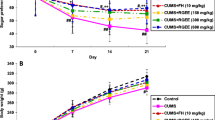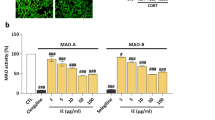Abstract
The development of anxiety and depression due to chronic exposure to stress is an emerging health problem. NCP formula is a combination of three medicinal herbs: Nelumbo nucifera, Centella asiatica, and Piper nigrum with neuroenhancement properties. The anti-anxiety- and antidepressant-like activities of NCP formula and possible mechanisms were investigated using a chronic mild stress–induced mouse model of depression. Administration of NCP formula to chronic mild stress mice significantly ameliorated anxiety, anhedonia, and hopeless behavior. NCP administration significantly normalized hypothalamic–pituitary–adrenal axis activation by reducing plasma corticosterone levels and downregulating serum- and glucocorticoid-inducible kinase 1 and upregulating glucocorticoid receptor mRNA expression in the frontal cortex and hippocampus of chronic mild stress mice. Moreover, NCP formula upregulated neurogenesis by increasing cyclic AMP-responsive element-binding protein and brain-derived neurotrophic factor mRNA expression in both brain regions. Extracts of each of the NCP herbal constituents inhibited monoamine oxidase A and B activity. The major bioactive compounds identified in the NCP formula extract were piperine, ferulic acid, terpenoids (madecassoside and asiaticoside), and flavonoids (quercetin, kaempferol, kaempferol-3-O-glucoside, rutin, and luteolin-7-O-glucoside).
Graphical Abstract











Similar content being viewed by others
Data Availability
The data from this study are available from the corresponding author upon reasonable request.
References
Badavath VN, Baysal İ, Uçar G, Mondal SK, Sinha BN, Jayaprakash V (2016) Monoamine oxidase inhibitory activity of ferulic acid amides: curcumin-based design and synthesis: design and synthesis of monoamine oxidase inhibitors. Arch Pharm Chem Life Sci 349:9–19. https://doi.org/10.1002/ardp.201500317
Behl T, Kaur D, Sehgal A, Singh S, Sharma N, Zengin G, Andronie-Cioara FL, Toma MM, Bungau S, Bumbu AG (2021) Role of monoamine oxidase activity in Alzheimer’s disease: an insight into the therapeutic potential of inhibitors. Molecules 26:3724. https://doi.org/10.3390/molecules26123724
Carradori S, Gidaro MC, Petzer A, Costa G, Guglielmi P, Chimenti P, Alcaro S, Petzer JP (2016) Inhibition of human monoamine oxidase: biological and molecular modeling studies on selected natural flavonoids. J Agric Food Chem 64:9004–9011. https://doi.org/10.1021/acs.jafc.6b03529
Chiba S, Numakawa T, Ninomiya M, Richards MC, Wakabayashi C, Kunugi H (2012) Chronic restraint stress causes anxiety- and depression-like behaviors, downregulates glucocorticoid receptor expression, and attenuates glutamate release induced by brain-derived neurotrophic factor in the prefrontal cortex. Prog Neuro-Psychoph 39:112–119. https://doi.org/10.1016/j.pnpbp.2012.05.018
Cryan JF, Valentino RJ, Lucki I (2005) Assessing substrates underlying the behavioral effects of antidepressants using the modified rat forced swimming test. Neurosci Biobehav Rev 29:547–569. https://doi.org/10.1016/j.neubiorev.2005.03.008
Daodee S, Monthakantirat O, Ruengwinitwong K, Gatenakorn K, Maneenet J, Khamphukdee C, Sekeroglu N, Chulikhit Y, Kijjoa A (2019) Effects of the ethanol extract of Dipterocarpusalatus leaf on the unpredictable chronic mild stress-induced depression in ICR mice and its possible mechanism of action. Molecules 24:3396. https://doi.org/10.3390/molecules24183396
Dhiman P, Malik N, Sobarzo-Sánchez E, Uriarte E, Khatkar A (2019) Quercetin and related chromenone derivatives as monoamine oxidase inhibitors: targeting neurological and mental disorders. Molecules 24:418. https://doi.org/10.3390/molecules24030418
Frisbee JC, Brooks SD, Stanley SC, d’Audiffret AC (2015) An unpredictable chronic mild stress protocol for instigating depressive symptoms, behavioral changes and negative health outcomes in rodents. J Vis Exp 106:e53109. https://doi.org/10.3791/53109
Gidaro MC, Astorino C, Petzer A, Carradori S, Alcaro F, Costa G, Artese A, Rafele G, Russo FM, Petzer JP, Alcaro S (2016) Kaempferol as selective human MAO-A inhibitor: analytical detection in Calabrian red wines, biological and molecular modeling studies. J Agric Food Chem 64:1394–1400. https://doi.org/10.1021/acs.jafc.5b06043
Gjerstad JK, Lightman SL, Spiga F (2018) Role of glucocorticoid negative feedback in the regulation of HPA axis pulsatility. Stress 21:403–416. https://doi.org/10.1080/10253890.2018.1470238
Gogineni V, Nael MA, Chaurasiya ND, Elokely KM, McCurdy CR, Rimoldi JM, Cutler SJ, Tekwani BL, León F (2021) Computationally assisted lead optimization of novel potent and selective MAO-B inhibitors. Biomedicines 9:1304. https://doi.org/10.3390/biomedicines9101304
Hritcu L, Noumedem JA, Cioanca O, Hancianu M, Kuete V, Mihasan M (2014) Methanolic extract of Piper nigrum fruits improves memory impairment by decreasing brain oxidative stress in amyloid beta (1–42) rat model of Alzheimer’s disease. Cell Mol Neurobiol 34:437–449. https://doi.org/10.1007/s10571-014-0028-y
Jorge OA, Jorge AD (2005) Hepatotoxicity associated with the ingestion of Centellaasiatica. Rev Esp Enferm Dig 97:115–124. https://doi.org/10.4321/s1130-01082005000200006
Karuppasamy M, Mahapatra M, Yabanoglu S, Ucar G, Sinha BN, Basu A, Mishra N, Sharon A, Kulandaivelu U, Jayaprakash V (2010) Development of selective and reversible pyrazoline based MAO-A inhibitors: synthesis, biological evaluation and docking studies. Bioorgan Med Chem 18:1875–1881. https://doi.org/10.1016/j.bmc.2010.01.043
Khamphukdee C, Chulikhit Y, Daodee S, Monthakantirat O (2017) Potential of Alternantheraphiloxeroides on improvement of anxiety-like behavior induced by ovariectomized mice model. IJPER 51:s493–s497. https://doi.org/10.5530/ijper.51.3s.73
Khamphukdee C, Turkmani I, Chotritthirong Y, Chulikhit Y, Boonyarat C, Sekeroglu N, Silva A, Monthakantirat O, Kijjoa A (2022) Effects of the bark resin extract of Garcinia nigrolineata on chronic stress-induced memory deficit in mice model and the in vitro monoamine oxidases and β-amyloid aggregation inhibitory activities of its prenylated xanthone constituents. Molecules 27:3014. https://doi.org/10.3390/molecules27093014
Lee SA, Hong SS, Han XH, Hwang JS, Oh GJ, Lee KS, Lee MK, Hwang BY, Ro JS (2005) Piperine from the fruits of Piper longum with inhibitory effect on monoamine oxidase and antidepressant-like activity. Chem Pharm Bull 53:832–835. https://doi.org/10.1248/cpb.53.832
Libert S, Pointer K, Bell EL, Das A, Cohen DE, Asara JM, Kapur K, Bergmann S, Preisig M, Otowa T, Kendler KS, Chen X, Hettema JM, Oord EJ, Rubio JP, Guarente L (2017) SIRT1 activates MAO-A in the brain to mediate anxiety and exploratory drive. Cell 147:1459–1472. https://doi.org/10.1016/j.cell.2011.10.054
Lopez-Lazaro M (2009) Distribution and biological activities of the flavonoid luteolin. Mini-Rev Med Chem 9:31–59. https://doi.org/10.2174/138955709787001712
Lozano-Sánchez J, Borrás-Linares I, Sass-Kiss A, Segura-Carretero A (2018) Chapter 13-Chromatographic technique: high-performance liquid chromatography (HPLC). In: Sun DW (ed) Modern techniques for food authentication (2nd Ed). Academic Press, pp 459–526
Malhi GS, Mann JJ (2018) Depression. The Lancet 392:2299–2312. https://doi.org/10.1016/S0140-6736(18)31948-2
Maneenet J, Daodee S, Monthakantirat O, Boonyarat C, Khamphukdee C, Kwankhao P, Pitiporn S, Awale S, Chulikhit Y, Kijjoa A (2019) Kleeb Bua Daeng, a Thai traditional herbal formula, ameliorated unpredictable chronic mild stress-induced cognitive impairment in ICR mice. Molecules 24:4587. https://doi.org/10.3390/molecules24244587
Maneenet J, Monthakantirat O, Daodee S, Boonyarat C, Chotritthirong Y, Kwankhao P, Pitiporn S, Awale S, Chulikhit Y (2021) Merging the multi-target effects of Kleeb Bua Daeng, a Thai traditional herbal formula in unpredictable chronic mild stress-induced cepression. Pharmaceuticals 14:659. https://doi.org/10.3390/ph14070659
Maneenet J, Omar AM, Sun S, Kim MJ, Daodee S, Monthakantirat O, Boonyarat C, Chulikhit Y, Awale S (2021) Benzylisoquinoline alkaloids from Nelumbonucifera Gaertn. petals with anti austerity activities against the HeLa human cervical cancer cell line. Z Naturforsch C 76:401–406. https://doi.org/10.1515/znc-2020-0304
Mineur YS, Belzung C, Crusio W (2006) Effects of unpredictable chronic mild stress on anxiety and depression-like behavior in mice. Behav Brain Res 175:43–50. https://doi.org/10.1016/j.bbr.2006.07.029
Mizuki D, Matsumoto K, Tanaka K, Le Thi X, Fujiwara H, Ishikawa T, Higuchi Y (2014) Antidepressant-like effect of Butea superba in mice exposed to chronic mild stress and its possible mechanism of action. J Ethnopharmacol 156:16–25. https://doi.org/10.1016/j.jep.2014.08.014
Monthakantirat O, Sukano W, Umehara K, Noguchi H, Chulikhit Y, Matsumoto K (2014) Effect of miroestrol on ovariectomy-induced cognitive impairment and lipid peroxidation in mouse brain. Phytomedicine 21:1249–1255. https://doi.org/10.1016/j.phymed.2014.06.012
Musigavong N, Boonyarat C, Chulikhit Y, Monthakantirat O, Limudomporn M, Pitiporn S, Kwankhao P, Daodee S (2022) Efficacy and safety of Kleeb Bua Daeng formula in mild cognitive impairment patients: a phase I randomized, double-blind, placebo-controlled trial. Evid-Based Compl Alt 2022:1148112. https://doi.org/10.1155/2022/1148112
Perveen S (2018) Introductory chapter: terpenes and terpenoids. In: Perveen S, Al-Taweel A (eds) terpenes and terpenoids. IntechOpen
Rao X, Huang X, Zhou Z, Lin X (2013) An improvement of the 2ˆ(–delta delta CT) method for quantitative real-time polymerase chain reaction data analysis. Biostat Bioinforma Biomath 3:71–85
Rodgers RJ (1997) Animal models of “anxiety”: where next? Behav Pharmacol 8:477–496. https://doi.org/10.1097/00008877-199711000-00003
Smith SM, Vale WW (2006) The role of the hypothalamic-pituitary-adrenal axis in neuroendocrine responses to stress. Dialogues Clin Neurosci 8:383–395. https://doi.org/10.31887/DCNS.2006.8.4/ssmith
Songvut P, Chariyavilaskul P, Tantisira M, Khemawoot P (2019) Safety and pharmacokinetics of standardized extract of Centellaasiatica (ECa 233) capsules in healthy Thai volunteers: a phase 1 clinical study. Planta Med 85:483–490. https://doi.org/10.1055/a-0835-6671
Subaraja M, Vanisree AJ (2019) The novel phytocomponent asiaticoside-D isolated from Centellaasiatica exhibits monoamine oxidase-B inhibiting potential in the rotenone degenerated cerebral ganglions of Lumbricusterrestris. Phytomedicine 58:152833. https://doi.org/10.1016/j.phymed.2019.152833
Syme KL, Hagen EH (2020) Mental health is biological health: why tackling “diseases of the mind” is an imperative for biological anthropology in the 21st century. Yearbook Phys Anthropol 171:87–117. https://doi.org/10.1002/ajpa.23965
Takano K, Yamasaki H, Kawabe K, Moriyama M, Nakamura Y (2012) Imipramine induces brain-derived neurotrophic factor mRNA expression in cultured astrocytes. J Pharmacol Sci 120:176–186. https://doi.org/10.1254/jphs.12039FP
Tan SC, Bhattamisra SK, Chellappan DK, Candasamy M (2021) Actions and therapeutic potential of madecassoside and other major constituents of Centellaasiatica: a review. Appl Sci 11:8475. https://doi.org/10.3390/app11188475
Zu X, Zhang M, Li W, Xie H, Lin Z, Yang N, Liu X, Zhang W (2017) Antidepressant-like effect of bacopaside I in mice exposed to chronic unpredictable mild stress by modulating the hypothalamic–pituitary–adrenal axis function and activating BDNF signaling pathway. Neurochem Res 42:3233–3244. https://doi.org/10.1007/s11064-017-2360-3
Acknowledgements
We thank the Research and Technology Transfer Affairs of Khon Kaen University, the Graduate School of Khon Kaen University, and the Research Program of Khon Kaen University for financial support. YCh. thanks the Faculty of Pharmaceutical Sciences, Khon Kaen University, Thailand, for a Master of Science scholarship and Chao Phya Abhaibhubejhr Hospital for logistical support. The authors thank Glenn Borlace for the English editing of the manuscript.
Funding
This research was supported by the Research and Technology Transfer Affair, Khon Kaen University, partially supported by the Research Program of Khon Kaen University 2021 (RP66-3–003) and Scholarships for the Master degree student, Faculty of Pharmaceutical Sciences, Khon Kaen University (ID: 2(1)/2562).
Author information
Authors and Affiliations
Contributions
OM, YC, SD, and CB conceived and designed the experiments. PK and SP identified the plants and provided the NCP formula. YCh performed the behavioral test, serum CORT assay, and gene expression. JM performed the HPLC analysis. CK performed MAOI assay. YCh and OM wrote the manuscript and assisted in the elaboration of the manuscript.
Corresponding author
Ethics declarations
Ethical Approval
The experimental protocol used in the study was following the Guiding Principle for the Care and Use of Animals (NIH Publications #8–23, revised in 2011) and was also approved by the Animal Ethics Committee of Khon Kaen University (approval no. IACUC-KKU-36/61).
Supplementary Information
Below is the link to the electronic supplementary material.
Rights and permissions
Springer Nature or its licensor (e.g. a society or other partner) holds exclusive rights to this article under a publishing agreement with the author(s) or other rightsholder(s); author self-archiving of the accepted manuscript version of this article is solely governed by the terms of such publishing agreement and applicable law.
About this article
Cite this article
Chotritthirong, Y., Chulikhit, Y., Daodee, S. et al. Possible Mechanisms for the Prevention of Anxiety and Depressive-Like Behavior in a Chronic Mild Stress Mouse Model by the Thai Herbal Medicine with Nelumbo nucifera, Centella asiatica, and Piper nigrum. Rev. Bras. Farmacogn. 33, 756–767 (2023). https://doi.org/10.1007/s43450-023-00401-x
Received:
Accepted:
Published:
Issue Date:
DOI: https://doi.org/10.1007/s43450-023-00401-x




